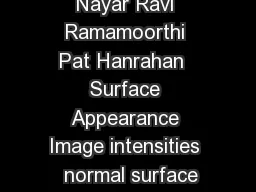

source sensor surface element normal brPage 3br BRDF Bidirectional Reflectance Distribution Function T I source viewing direction surface element normal incident direction I T I T surface I T surface I T Irradiance at Surface in direction I T Radian ID: 27035
Download Pdf The PPT/PDF document "Basic Principles of Surface Reflectance ..." is the property of its rightful owner. Permission is granted to download and print the materials on this web site for personal, non-commercial use only, and to display it on your personal computer provided you do not modify the materials and that you retain all copyright notices contained in the materials. By downloading content from our website, you accept the terms of this agreement.
Basic Principles of Surface Reflectance Thanks to Shree Nayar, Ravi Ramamoorthi, Pat Hanrahan Surface Appearance Image intensities = f ( normal, surface reflectance, illumination ) Surface Reflection depends on both the viewing and illumination direction. source sensor surface element normal BRDF: Bidirectional Reflectance Distribution Function x y z source viewing direction surface element normal incident direction Irradiance at Surface in direction Radiance of Surface in direction BRDF : Important Properties of BRDFs x y z source viewing direction surface element normal incident direction BRDF is only a function of 3 variables : • Rotational Symmetry: Appearance does not change when surface is rotated about the normal. • Helmholtz Reciprocity: (follows from 2 nd Law of Thermodynamics) Appearance does not change when source and viewing directions are swapped. Mechanisms of Surface Reflection source surface reflection surface incident direction body reflection Body Reflection: Diffuse Reflection Matte Appearance Non - Homogeneous Medium Clay, paper, etc Surface Reflection: Specular Reflection Glossy Appearance Highlights Dominant for Metals Image Intensity = Body Reflection + Surface Reflection Mechanisms of Surface Reflection Body Reflection: Diffuse Reflection Matte Appearance Non - Homogeneous Medium Clay, paper, etc Surface Reflection: Specular Reflection Glossy Appearance Highlights Dominant for Metals Many materials exhibit both Reflections: Diffuse Reflection and Lambertian BRDF Diffuse Reflection and Lambertian BRDF viewing direction surface element normal incident direction • Lambertian BRDF is simply a constant : albedo • Surface appears equally bright from ALL directions! (independent of ) • Surface Radiance : • Commonly used in Vision and Graphics! source intensity source intensity I Rendered Sphere with Lambertian BRDF • Edges are dark (N.S = 0) when lit head - on • See shading effects clearly. White - out Conditions from an Overcast Sky CAN’T perceive the shape of the snow covered terrain! CAN perceive shape in regions lit by the street lamp!! WHY? Specular Reflection and Mirror BRDF source intensity I viewing direction surface element normal incident direction specular/mirror direction • Mirror BRDF is simply a double - delta function : • Very smooth surface. • All incident light energy reflected in a SINGLE direction. (only when = ) • Surface Radiance : specular albedo • Delta Function too harsh a BRDF model (valid only for highly polished mirrors and metals). • Many glossy surfaces show broader highlights in addition to mirror reflection. • Surfaces are not perfectly smooth – they show micro - surface geometry (roughness). • Example Models : Phong model Torrance Sparrow model Glossy Surfaces Blurred Highlights and Surface Roughness Roughness Phong Model: An Empirical Approximation • How to model the angular falloff of highlights: Phong Model Blinn - Phong Model • Sort of works, easy to compute • But not physically based (no energy conservation and reciprocity). • Very commonly used in computer graphics. - S R E H N N Phong Examples • These spheres illustrate the Phong model as lighting direction and n shiny are varied: Those Were the Days • “In trying to improve the quality of the synthetic images, we do not expect to be able to display the object exactly as it would appear in reality, with texture, overcast shadows, etc. We hope only to display an image that approximates the real object closely enough to provide a certain degree of realism.” – Bui Tuong Phong, 1975 All components of Surface Reflection Reflections on water surfaces - Glittering Split off - specular Reflections in Woven Surfaces Why does the Full Moon have a flat appearance? • The moon appears matte (or diffuse) • But still, edges of the moon look bright (not close to zero) when illuminated by earth’s radiance. Why does the Full Moon have a flat appearance? Lambertian Spheres and Moon Photos illuminated similarly Surface Roughness Causes Flat Appearance Actual Vase Lambertian Vase Surface Roughness Causes Flat Appearance Increasing surface roughness Lambertian model Valid for only SMOOTH MATTE surfaces. Bad for ROUGH MATTE surfaces. Oren - Nayar Model – Main Points • Physically Based Model for Diffuse Reflection. • Based on Geometric Optics. • Explains view dependent appearance in Matte Surfaces • Take into account partial interreflections. • Roughness represented like in Torrance - Sparrow Model • Lambertian model is simply an extreme case with roughness equal to zero. A Simple Reflection Model - Dichromatic Reflection Observed Image Color = a x Body Color + b x Specular Reflection Color R G B Klinker - Shafer - Kanade 1988 Color of Source (Specular reflection) Color of Surface (Diffuse/Body Reflection) Does not specify any specific model for Diffuse/specular reflection